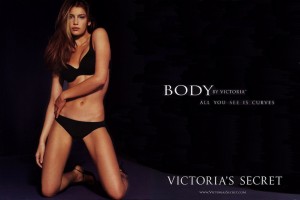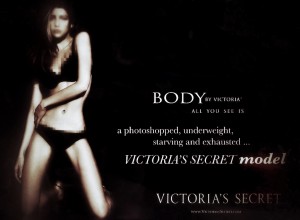1. Original ad

2. Brief written analysis
The above advertisement is a promotion for Victoria’s Secret Body by Victoria line from 2013. Currently the largest American retailer of women’s lingerie, Victoria’s Secret enjoys a great deal of regional and global recognition due to the use of supermodels as brand ambassadors and other expensive marketing strategies such as its annual fashion show. Body by Victoria is a collection that offers everyday basic lingerie and it is known for providing the most comfortable fit for women of all body types. My chosen advertisement gives off a sleek and simple impression. The color use is dark which intends to represent sexiness and mystery much like the model who appears to be timid yet sexy.
Victoria’s Secret is known for hiring models who are exceptionally skinny. For Body by Victoria, the collections come in many styles ranging from size A-DDD and XS to XL. However, the portrayal in this advertisement merely showcases a thin and bony woman. Moreover, the model’s posture and facial expression suggest a rather seductive image, which does not seem too comfortable to the audience. The ads itself contradicts with what the product is supposed to offer – everyday comfort lingerie for ALL women. On top of that, the phrase “ALL YOU SEE IS CURVES” raises my attention. The statement basically conveys a meaning that being curvy is an ideal, or that the product would make you look curvy once being worn. However, reality is that majority of the customers who shop at Victoria’s Secret do not have the same build as the model. They are probably not going to end up looking like the model in the same set of lingerie. As a result, many women become unsatisfied with their own bodies. They are victims to an indirect form of body-shamming. This issue is particularly problematic because so many women are “brainwashed” to think that Victoria’s Secret models are ultimate role models to follow. Teenage girls are more susceptible to indulge in unhealthy popular beliefs since their peers oftentimes fantasize about being just like one of the models and the mass media further reinforces the same notion.
3. Culture-Jammed!

4. Brief written explanation
At first glance, the altered work almost looks an advertisement for horror movie. My intention is to elicit the dark side of both the modeling industry and marketing sector, especially for my chosen brand Victoria’s Secret. The company spends millions of dollars annually to achieve impeccable and extensive marketing strategies. Since it has such international fame, consumers are very sensitive to whatever the brand promotes. The original advertisement suggests a rather unrealistic representation of a “good-looking” body type which requires the woman going on strict diet combined with the effects of make-up and professional photo editing skills; or the woman could be naturally thin and tall. With all these factors into consideration, the “deals” are usually rare to find in everyday life. My alteration reveals a obscure image with an obviously anorexic woman who is mentally and physically worn out from overwork. The blurred face hints a frowning face, in a way it is to show a disconnect with her own identity. Others might admire her for having the “privilege” to work as a Victoria’s Secret model and some people might aspire to look just like her. However, her blurred face and pixelated areas reveal her insecurities. I want to establish a notion that the models used for big named brands often struggle with their career advancement because the competition is so intense. Most people know about the harsh reality, but they do not immediately have this kind of association when they see advertisements featuring beautiful models. Hence, consumers are vulnerable to fall into false beliefs that these advertisements show the social expectations, which might leads to inexplicitly encouraging them to converge to these social norms. My alteration aspires to reveal the false, unrealistic representations of norms that are not necessarily healthy inspirations. Consumers should give a second thought before falling into the assumption that they should engage in socially conforming behaviors.